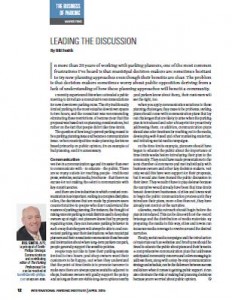In more than 20 years of working with parking planners, one of the most common frustrations I’ve heard is that municipal decision-makers are sometimes hesitant to try new planning approaches even though their benefits are clear. The problem is that decision-makers sometimes worry about public opposition deriving from a lack of understanding of how these planning approaches will benefit a community.
I recently experienced this when I attended a public meeting to introduce a consultant’s recommendations for new downtown parking rules. The city traditionally limited parking in the most valuable downtown spaces to two hours, and the consultant was recommending eliminating these restrictions. It became clear that this proposal was based not on planning considerations, but rather on the fact that people didn’t like time limits.
The question of how long to permit parking ceased to be a parking planning issue and became a communication issue. When municipalities make planning decisions based primarily on public opinion, it’s an example of bad planning. And it’s unnecessary.
Communication
We live in a communication age and it’s easier than ever to communicate with—to educate—the public. There are so many outlets for reaching people—traditional press, websites, social media, brochures—that there’s no excuse for not making the effort to communicate with key constituencies.
And there are few industries in which constant communication is as important. Parking is a complex discipline. Often, the decisions that are made by planners seem counterintuitive to people who don’t understand the nuances of parking planning. For instance, the thought of raising rates for parking in retail districts used to keep shop owners up at night. But planners know that by properly regulating rates, they can influence parking behavior in such a way that shoppers will always be able to find convenient parking near their destinations. When municipal planners and their consultants communicate these benefits and information about where long-term parkers can park, people generally support the sensible policies.
People may not like to have their parking sessions limited to two hours (and shop owners want their customers to be happy). But when they understand that the point of time limits is to promote turnover to make sure there are always spaces available adjacent to shops, business owners will gladly support the policy. And as long as there are viable long-term options nearby (and parkers know about them), their customers will see the light, too.
When you apply communication solutions to these planning challenges, they cease to be problems. Parking plans should come with communication plans that lay out challenges that are likely to arise when the parking plan is introduced and offer a blueprint for proactively addressing them. In addition, communication plans should also offer timelines for reaching out to the media, developing web-based and other marketing materials, and initiating social media campaigns.
In the time limits example, planners should have begun to educate the public about the importance of time limits weeks before introducing their plan to the community. They could have made presentations to the local chamber of commerce and met individually with business owners and other key decision-makers. Not only would this have won support for their proposals, but it would also have framed the public discussion in their favor. They wouldn’t have to play defense because the narrative would already have been that time limits benefit downtown businesses. If cities and towns wait to begin the public communication process until they introduce their plans, more often than not, they have already lost control of the narrative.
Likewise, media outreach should begin before the plan is introduced. This can be done with off-the-record briefings and the distribution of media materials. By preparing the media in this way, cities and towns can influence media coverage to revolve around the desired narrative.
Finally, social media campaigns and the introduction of materials such as websites and brochures should be timed to educate the public about plans and their benefits. A comprehensive communication plan that addresses anticipated community concerns and offers messaging to address them, along with a step-by-step communication strategy and schedule, can be the difference between success and failure when it comes to gaining public support. It can also eliminate the risk of making bad planning decisions because you’re worried about public opinion.
Bill Smith, APR, is principal of Smith-Phillips Strategic Communications and contributing editor of The Parking Professional. He can be reached at bsmith@smith-phillips.com or 603.491.4280.
TPP-2015-04-Leading the Discussion

